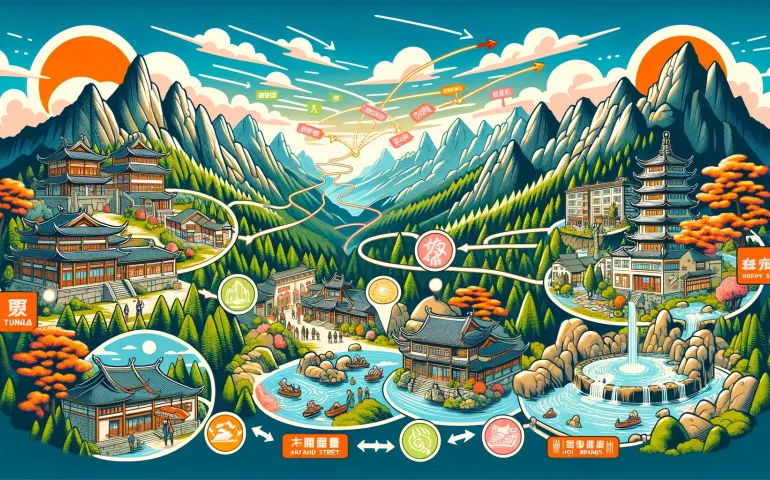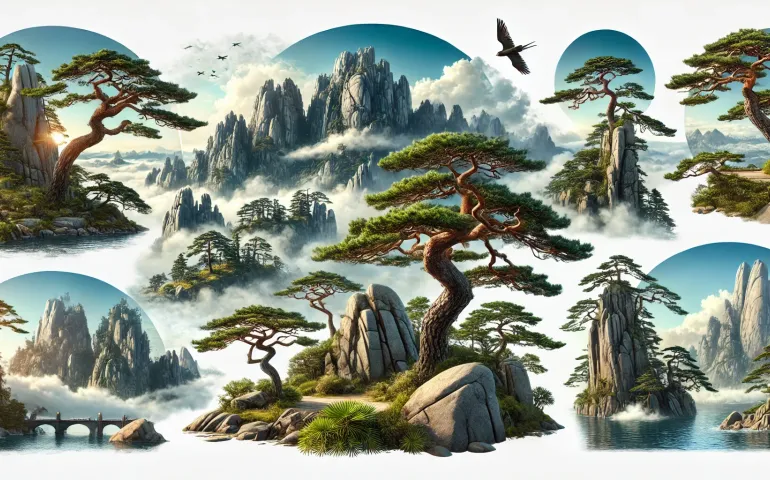About Place
- "A marvel of nature with its granite peaks, hot springs, and ancient pine trees."
- "A surreal landscape that inspired traditional Chinese paintings."
- "A paradise for hikers and photographers alike."
Reasons to Visit
- Stunning Natural Beauty: Huangshan is renowned for its dramatic scenery featuring towering granite peaks, uniquely shaped pine trees, and ethereal seas of clouds. The mountain range has inspired countless artists and poets over the centuries, contributing significantly to Chinese cultural heritage. The distinctive landscape, with its mystical aura and striking vistas, offers visitors a surreal experience that feels like stepping into a traditional Chinese painting.
- Rich Cultural and Historical Significance: The mountain has been a significant subject in Chinese art and literature. The ancient paths and temples scattered throughout Huangshan provide a glimpse into the spiritual and cultural history of China. The area is also home to the ancient villages of Hongcun and Xidi, both UNESCO World Heritage Sites, which showcase well-preserved traditional Anhui architecture and offer a window into China's past.
- Outdoor Activities and Adventure: Huangshan is a haven for outdoor enthusiasts. The mountain's numerous trails cater to both casual hikers and serious trekkers, offering a range of difficulty levels. The breathtaking sunrise and sunset views from various peaks are highlights not to be missed. Additionally, the hot springs at the base of the mountain provide a perfect way to relax after a day of exploring.
Visa
- Tourist Visa (L Visa): Required for most travelers.
- Application Components:
- Completed application form.
- Passport-sized photos.
- Proof of travel arrangements (e.g., flight and hotel bookings).
- Valid passport.
- Visa-Free Transit Policies: Available for certain nationalities in specific cities.
- Important Note: Always check the latest requirements from the Chinese consulate or embassy in your home country.
Travel Expenses
- Travel to & from Destination:
- Round-trip flight from the nearest metro city (e.g., Shanghai) to Huangshan: $200 per person.
- Total for two people: $400.
- Hotel Cost:
- Average hotel cost per night: $100.
- Total for three nights: $300.
- Food Cost:
- Average meal cost per person per day: $30.
- Total for three days for two people: $180.
- Activity Cost:
- Cable car tickets: $30 per person.
- Entrance fees for scenic areas: $50 per person.
- Hot springs: $20 per person.
- Total for two people: $200.
- Near Destination Travel Cost:
- Car rental for three days: $150.
- Total Estimated Travel Expenses: $1230.

Best Itinerary
Day 1: Arrival and Exploration
Arrive in Huangshan City, and check into a comfortable hotel like the Huangshan International Hotel. After settling in, visit the Tunxi Ancient Street for an afternoon stroll from 2 PM to 5 PM. This charming street is lined with ancient buildings, shops, and tea houses. Enjoy local Anhui cuisine for lunch at Lao Jie Di Yi Lou, known for its traditional dishes. In the evening, dine at Mei Shi Ren Jia to try Huangshan's famous stinky tofu and other local delicacies. Spend the night exploring the vibrant Tunxi nightlife, or relax at your hotel.
Day 2: Scenic Peaks and Hot Springs
Start early at 6 AM to catch a cable car up to the summit of Huangshan. Spend the day hiking and exploring iconic spots like the Bright Summit, Flying Over Rock, and the West Sea Grand Canyon until 3 PM. Have lunch at the Xihai Hotel restaurant on the mountain, where you can enjoy scenic views while dining. After descending, head to the Huangshan Hot Springs from 5 PM to 7 PM to unwind. For dinner, visit the nearby Tangkou Old Street and try the local specialty, bamboo shoots with chicken, at Jinsong Renjia Restaurant.
Day 3: Cultural Villages and Departure
Begin with a visit to the ancient villages of Hongcun and Xidi, starting at 9 AM and spending around 2 hours in each. These UNESCO World Heritage Sites offer a glimpse into traditional Chinese village life and architecture. Have lunch at the Hongcun Moon Pond Restaurant, known for its authentic Anhui dishes. In the afternoon, return to Huangshan City for a leisurely walk along the Xin'an River until 4 PM. For dinner, enjoy a farewell meal at the Tuxi Ancient Street's Liyuan Restaurant before heading back to your hotel to prepare for departure the next morning.

Safety Tips
- Always carry a copy of your passport and visa.
- Stay hydrated and carry snacks while hiking.
- Wear appropriate footwear for mountain trails.
- Be cautious of changing weather conditions.
- Keep your belongings secure, especially in crowded areas.
- Respect local customs and traditions.
- Have emergency contact numbers handy.
- Use only licensed taxis and transport services.
- Purchase travel insurance.
- Inform someone of your daily travel plans.
Flights
- China Eastern Airlines: Shanghai to Huangshan, 1.5 hours, approx. $100.
- Juneyao Airlines: Beijing to Huangshan, 2 hours, approx. $150.
Hotels
- Huangshan International Hotel
- Xihai Hotel (on the mountain)
- Huangshan Baiyun Hotel
- Tunxi Lodge
- Hongcun Zhaixiangju Guesthouse
Contacts
- Indian Embassy in Beijing: +86-10-8531-2500
- Police: 110
- Ambulance: 120
- Firefighters: 119
Country
Closet Airport
- Chinese Yuan (CNY)
Nearest City
- Shanghai
Heritage Sites
Hongcun and Xidi Villages
Airlines
- China Eastern
- Juneyao Airlines
- Air China
Currency
- Huangshan Tunxi International Airport (TXN)
Languages Spoken
- Mandarin Chinese
Real Story
In the annals of Chinese history, Xu Xiake stands out as a pioneering travel writer and geographer of the late Ming Dynasty. Born in 1587 in Jiangsu province, Xu devoted his life to exploring the diverse landscapes of China. Among his numerous journeys, his expedition to Huangshan (Yellow Mountain) in 1616 remains one of the most celebrated.
Xu Xiake embarked on his journey to Huangshan with the aim of meticulously documenting its geographical and natural features. At that time, Huangshan was relatively unknown, and its rugged terrain and remote location made it an adventurous undertaking. Xu's journey was arduous, involving steep climbs, treacherous paths, and unpredictable weather. Yet, his determination was fueled by a passion for discovery and a desire to bring the wonders of Huangshan to the attention of the wider world.
His travel diaries, later compiled into the monumental work "Xu Xiake's Travel Diaries," provide an in-depth account of his experiences. Xu Xiake's descriptions of Huangshan are vivid and poetic, capturing the essence of its stunning landscapes. He wrote about the majestic granite peaks, some of which rise over 1,800 meters above sea level, and the uniquely shaped pine trees clinging to the rocks. His narrative vividly depicted the ethereal seas of clouds that envelop the mountain, creating a mystical and ever-changing scenery.
One of the most significant aspects of Xu's writings is his detailed observations of the natural environment. He meticulously recorded the flora and fauna of Huangshan, noting the diverse species of plants and animals that inhabit the region. His scientific approach to documenting the landscape was ahead of his time, blending poetic expression with empirical observation.
Xu Xiake's exploration of Huangshan had a profound impact on Chinese culture and tourism. His accounts brought the beauty of Huangshan to the forefront of public consciousness, inspiring countless artists, poets, and travelers. The mountain became a symbol of natural beauty and spiritual inspiration, often depicted in traditional Chinese paintings and literature.
Today, Xu Xiake is celebrated as one of China's greatest explorers. His journey to Huangshan not only enriched the historical and cultural heritage of China but also contributed to the recognition of Huangshan as a UNESCO World Heritage Site. Visitors to Huangshan often retrace his steps, marveling at the same vistas that Xu Xiake so eloquently described over 400 years ago.
Cuisine
Huangshan's cuisine is an integral part of Anhui (Huizhou) cuisine, one of the Eight Great Culinary Traditions of China. Known for its rich flavors and use of natural ingredients, the cuisine of Huangshan offers a delightful culinary experience that reflects the region's unique geography and cultural heritage.
Key Dishes:
- Bamboo Shoots with Chicken (冬笋鸡汤): Bamboo shoots are a staple ingredient in Huangshan cuisine, and their combination with tender chicken creates a flavorful and nutritious dish. The bamboo shoots are typically harvested from the surrounding mountains, providing a fresh and earthy taste that complements the savory chicken broth.
- Stinky Tofu (臭豆腐): Despite its pungent smell, stinky tofu is a beloved delicacy in Huangshan. The tofu is fermented and then deep-fried to achieve a crispy exterior while maintaining a soft, creamy interior. It is often served with a spicy sauce, balancing the bold flavors and making it a popular street food.
- Huizhou Braised Pork (徽州红烧肉): This dish features succulent pieces of pork belly slow-cooked in a rich soy sauce-based marinade. The pork is caramelized to perfection, resulting in a tender and flavorful dish. It is a staple in Huizhou cuisine, known for its comforting and hearty qualities.
Unique Ingredients and Cooking Techniques:
Huangshan cuisine emphasizes the use of local ingredients sourced from its pristine natural environment. Wild herbs, bamboo shoots, and mountain vegetables are commonly used, imparting a distinct freshness to the dishes. The region's traditional cooking techniques include braising, stewing, and steaming, which help to preserve the natural flavors and nutritional value of the ingredients.
Culinary Experience:
Dining in Huangshan is not just about the food; it's about the overall experience. Meals are often enjoyed in traditional Anhui-style restaurants with wooden interiors and intricate carvings, creating an ambiance that reflects the region's cultural heritage. Many restaurants in the area pride themselves on serving authentic Huizhou cuisine, offering both locals and visitors a genuine taste of Huangshan's culinary delights.
Huangshan's cuisine is a testament to the region's rich cultural history and its deep connection to nature. Each dish tells a story of the land and its people, making it a memorable part of any visit to this breathtaking destination.

Culture and History
Huangshan's culture is deeply intertwined with its natural beauty and historical significance. The mountain range has inspired countless works of art, poetry, and literature throughout Chinese history. The local culture reflects a harmonious relationship with nature, emphasizing simplicity, tranquility, and respect for the environment.
The traditional Anhui architecture seen in the ancient villages of Hongcun and Xidi showcases intricate woodwork, ornate carvings, and well-preserved residences that offer a glimpse into China's past. The local people maintain a lifestyle that honors their heritage, with festivals, traditional music, and dance playing a significant role in their cultural identity.
